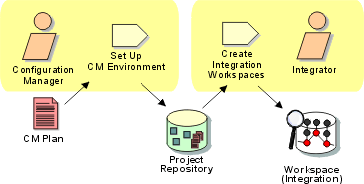Workflow Detail: Create
Project Configuration Management (CM) Environments
|
The purpose of this workflow detail is to establish an environment where the overall product can be developed, built, and be made available for stakeholders. |
|
|
|
Description

This work is done by making sure the essential artifacts are available to developers and integrators in the various private and public workspaces as they need them, and then are adequately baselined and stored for subsequent use. Setting up the CM environment involves creating the product directory structure, repositories, workspaces (developer and integration) and allocating machine resources (servers and disk space).
Related Information 
This section provides links to additional information related to this workflow detail.
Timing 
Typically this work starts in Inception and continues throughout the lifecycle. Generally this work is most prevalent in iterations at the very beginning of each phase (or at the end of each preceding phase) to prepare a suitable CM environment for the forthcoming phase. Note that the requirements for a CM environment often change from phase-to-phase as the team size expands and contracts: a smaller development team in early phases normally requires a less formal environment than is required in later phases.
Optionality 
This work is not considered optional, although project culture will mean this work will vary from being a small consideration to a large endeavor. Note that where an existing CM environment is in place, this work may be more focused on tailoring that environment to suit the project or lifecycle phase.
How to Staff

To set up an appropriate environment, a person playing the Configuration Manager role needs to have a good understanding of the component structures of the overall product, and will need to work closely with the software architect to ensure that adequate "place holder" CM items are established.
A person playing the Integrator role in this work needs to ensure that artifacts delivered from the developer workspaces are sufficiently tested such that they can be incorporated into a testable build. The Integrator role needs to be familiar with Project CM Policies, Build and Test Practices.
Work Guidelines

See the Related Information section for additional guidance that will help you in performing this work.

